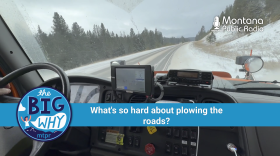People have lived in Big Sky Country for a little more than 10,000 years. But living things creeped and crawled and swam around here for hundreds of millions of years before then. A Big Why listener wanted to know when life showed up in the place we now call Montana. MTPR's Austin Amestoy visited the fossil archive at the University of Montana to unearth the answer.
Austin Amestoy: Welcome to the Big Why, a series from Montana Public Radio where we find out what we can discover together.
I’m your host, Austin Amestoy.
This is a show about listener-powered reporting. We’ll answer questions — large or small — about anything under the Big Sky. By Montanans for Montana, this is The Big Why.
Today, I’m going to attempt to walk through, oh, 1.5 billion years of Montana history over the next nine minutes. Nick Mott is here to help us with the task. Hi, Nick!
Nick Mott: Hey, Austin. That’s a pretty ambitious goal! What’s taking us so far back in time?
Austin Amestoy: That would be a question from Big Why listener Brian Linsenbardt who lives up in the Flathead region. He asked a lot of questions about Montana prior to the last ice age — when do the first living things show up in our fossil record? What about mammals? When did people first arrive in the Treasure State?
No question is too grand for the Big Why, Nick, so I figured we’d wind back the clock and take a stroll through the pre-history of the place we now call Montana.
Nick Mott: Sounds like we’d better jump right in! Who’d you find to help us out?
Austin Amestoy: Well, here’s a voice devoted Big Why listeners might recognize.
Kallie Moore: “Thanks for having me back again! I’m very excited to show you around the collection today.”
Nick Mott: That sounds like Kallie Moore! I remember her from the Little Why episode we did on the first dinosaur found in Montana.
Austin Amestoy: That’s right, Nick. Moore is a self-described “fossil librarian” at the University of Montana. We meet up in a musty basement room on campus where these colossal shelves were crammed up against one another.

Kallie Moore: “It’s fairly large. It fits 192 cases that are about three feet high, two-and-a-half-feet wide and about three feet deep.”
Austin Amestoy: “That’s a lot of fossils.”
Kallie Moore: “That’s a lot of fossils.”
Nick Mott: Yeah, that sounds pretty impressive, especially with all of them stored in one room.
Austin Amestoy: It really is. Moore uses that collection to take me through Montana’s fossil history, starting with the oldest life detected in Montana — something that didn’t even leave bones behind.
She lifts a strange, wavy rock from its place on the table.
Kallie Moore: “Here’s a piece — it’s from near Augusta, over on our side of the Continental Divide. And you can see, there’s all these tiny little lines, but it all forms lumps as you look through it.”
Nick Mott: So, this rock doesn’t have bones, but does show signs of life?
Austin Amestoy: That’s right. The rock is called a “stromatolite.” It’s about 1.5 billion years old. Mind you, Earth is 4.5 billion years old, so the oldest evidence we have of life in this state begins to show up about two thirds of the way through geologic time.
Back then, a big, gooey mat of cyanobacteria made those wavy lines as it trapped layers of sediment.
Nick Mott: Wow. So, this kind of cyanobacteria is the oldest living thing we know of that once lived in Montana?
Austin Amestoy: Yep. Although, the Montana of 1.5 billion years ago looked absolutely nothing like it does today. I talked a bit about this with David Varricchio. He’s a paleontologist at Montana State University in Bozeman. Back when that stromatolite formed, Varricchio says the atmosphere was changing, the Earth was mostly ocean, and land was barren and rugged.
David Varricchio: “But you can think, this is a landscape where the only thing around is bacteria. So, it would be very strange. It’s kind of weird to ponder what that landscape might look like.”
Nick Mott: Yeah, that sounds pretty alien to me. So, how long does it take to find evidence of more complex life in Montana?
Austin Amestoy: For that, it’s time to fast forward, oh, just a billion years or so. Fossil librarian Kallie Moore opens one of those big metal cabinets and shuffles through a few drawers before she finds what she’s looking for.
Kallie Moore: “So these are the little things that look kind of like pill bugs, or isopods from the seafloor today. We do think they rolled up, just like pill bugs do — or roly polys, as I always call them.”

Austin Amestoy: In the drawer are dozens of rocks with tons of small, segmented trilobites, as they’re called. Moore says these guys dominated life on earth for hundreds of millions of years, largely sticking to the oceans.
Nick Mott: Montana seems to be underwater for a lot of its early history!Austin Amestoy: It absolutely was, Nick. Much of the state we know today was underwater for millions or billions of years at a time. But, lots of our really old marine fossils are found in the mountains of western Montana. That’s where those stromatolites and trilobites pop up. I’ll let our paleontologist, David Varricchio, explain.
David Varricchio: “Because they were buried deeply, they’re earlier in time — buried more deeply. So, you need geologic events — mountain-building, intrusions of magma — to push those rocks up to the surface.”
Austin Amestoy: So, to recap — the earliest life in Montana shows up about 1.5 billion years ago, and begins to diversify about 500 million years ago. Now it’s time to fast forward to 325 million years ago. Oceans were teeming with life and land was covered in huge rainforests.
Moore opens a drawer with a fossil of a small fish imprinted in a rock. It has an unusual spiny back fin, armored scales on its belly and a downward-facing mouth.
Kallie Moore: “So, we think this fish would’ve swam a little bit and then laid on the seafloor and nibbled a little something — swam, laid on the seafloor, nibbled a little something.”

Nick Mott: And that was found here in Montana?
Austin Amestoy: Yes — many such fish are found in the Bear Gulch limestone of central Montana.
Nick Mott: I had no idea we had such a diversity of fossils here. I think most people probably only think about the dinosaur discoveries out in eastern Montana.
Austin Amestoy: Oh yes, and rightfully so. Moore says the rock out east is actually some of the youngest in the state, dating back to the final days of the dinosaurs. This was around the time Montana would've started looking somewhat recognizable: plains covered by a shallow sea in the east, with mountains beginning to rise in the west.
And this is when Moore says the first small, squirrel-like mammals show up in our fossil record, too — even though they’d been around for millions of years prior in other parts of the world.
Nick Mott: OK. One last thing, then: humans. You said our listener wanted to know when we showed up in Montana. How far back do we go for that?
Austin Amestoy: Well, put this in perspective, Nick — we started this episode 1.5 billion years ago. The best archaeological evidence we have right now puts humans in Montana roughly 11,000 years ago. Doing some quick math here — that means, to the best of our knowledge, humans have lived in Montana for roughly seven ten-thousandths of a percent of the time life has been here.
Nick Mott: Whoa. That is completely wild. How did Indigenous Americans get here, anyway?
Austin Amestoy: That brings us to our last expert, anthropologist Douglas MacDonald. He’s a professor at the University of Montana who studies the first Montanans. He says available evidence points to the first Americans migrating from northeast Asia, across the Bering Land Bridge, and down into the states.
Douglas MacDonald: “I think, without much doubt, that those first people probably migrated down the Pacific coast before 12,000 years ago.Austin Amestoy: Montana was actually really hard to get to during the end of the last ice age. A huge ice sheet in Canada largely blocked access from the north, and a glacial lake where Missoula is now would have blocked many travelers from the west.
MacDonald says it's most likely that the first Montanans came down through a gap in the ice about 11,000 years ago.
Douglas MacDonald: “Depends on how you interpret the data, but Montana might have been one of the last places for people to actually get to. We just don’t know the answer.”
Austin Amestoy: He says new archaeological finds are still unearthing new evidence about Montana’s ancient past — so you never know what we might learn next.
Nick Mott: A billion years in nine minutes. Nice work, Austin!
Austin Amestoy: Thanks, Nick! Now we want to know what makes you curious about Montana! You can submit your questions online at bigwhy.org.
Find us wherever you listen to podcasts. And help others find the show by sharing it and leaving us a review. Let’s see what we can discover together.
-
When it comes to winter driving, everyone wants their route clear and dry, and they want it done quickly. Why don't the plows come sooner or more often? Why don't they drop more salt or deicer? Why not get more drivers on the road? Tag along as a Montana snowplow driver prepares for a big winter storm and find out more about the logistical, environmental and technical challenges that come with keeping the roads clear of snow.
-
How do cabbage and spices become ingredients for community building? In Korea, the answer is kimjang, the fall tradition of making and sharing kimchi. This week on The Big Why, we visit a farm in the Bitterroot Valley where a group of Montanans came together to keep a food custom alive and find comfort and connection among the cabbage.
-
In Montana, abortion access has been at times illegal, legal, and stuck in limbo. Providers have weathered bombings and arson, advocates and opponents have battled it out in court, and citizens have passed a constitutional amendment affirming a woman's right to choose. One listener wants to know more about the history of reproductive rights in Montana. MTPR's Aaron Bolton reports on the underground networks, political violence and landmark court cases that got us to where we are today.
-
A flag's primary purpose is to be recognized from a distance. That means few colors, no lettering and a clear distinction from other flags. Ideally, it should be simple enough for a child to draw it from memory. So, how did Montana end up with such a complicated flag? Learn more in this episode of The Big Why.








